Alon Benhaim
Phi-4-Mini Technical Report: Compact yet Powerful Multimodal Language Models via Mixture-of-LoRAs
Mar 03, 2025Abstract:We introduce Phi-4-Mini and Phi-4-Multimodal, compact yet highly capable language and multimodal models. Phi-4-Mini is a 3.8-billion-parameter language model trained on high-quality web and synthetic data, significantly outperforming recent open-source models of similar size and matching the performance of models twice its size on math and coding tasks requiring complex reasoning. This achievement is driven by a carefully curated synthetic data recipe emphasizing high-quality math and coding datasets. Compared to its predecessor, Phi-3.5-Mini, Phi-4-Mini features an expanded vocabulary size of 200K tokens to better support multilingual applications, as well as group query attention for more efficient long-sequence generation. Phi-4-Multimodal is a multimodal model that integrates text, vision, and speech/audio input modalities into a single model. Its novel modality extension approach leverages LoRA adapters and modality-specific routers to allow multiple inference modes combining various modalities without interference. For example, it now ranks first in the OpenASR leaderboard to date, although the LoRA component of the speech/audio modality has just 460 million parameters. Phi-4-Multimodal supports scenarios involving (vision + language), (vision + speech), and (speech/audio) inputs, outperforming larger vision-language and speech-language models on a wide range of tasks. Additionally, we experiment to further train Phi-4-Mini to enhance its reasoning capabilities. Despite its compact 3.8-billion-parameter size, this experimental version achieves reasoning performance on par with or surpassing significantly larger models, including DeepSeek-R1-Distill-Qwen-7B and DeepSeek-R1-Distill-Llama-8B.
POROver: Improving Safety and Reducing Overrefusal in Large Language Models with Overgeneration and Preference Optimization
Oct 16, 2024
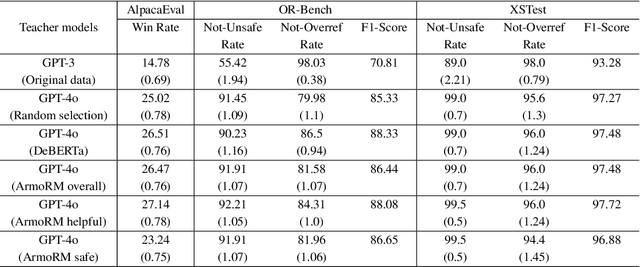
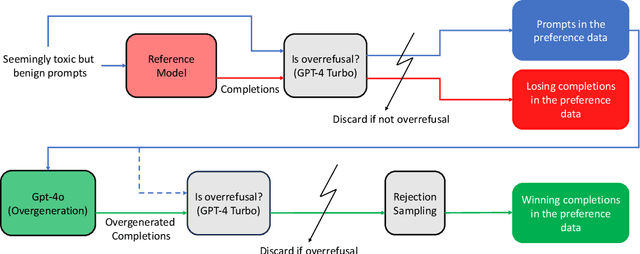

Abstract:Balancing safety and usefulness in large language models has become a critical challenge in recent years. Models often exhibit unsafe behavior or adopt an overly cautious approach, leading to frequent overrefusal of benign prompts, which reduces their usefulness. Addressing these issues requires methods that maintain safety while avoiding overrefusal. In this work, we examine how the overgeneration of training data using advanced teacher models (e.g., GPT-4o), including responses to both general-purpose and toxic prompts, influences the safety and overrefusal balance of instruction-following language models. Additionally, we present POROver, a strategy to use preference optimization methods in order to reduce overrefusal, via employing a superior teacher model's completions. Our results show that overgenerating completions for general-purpose prompts significantly improves the balance between safety and usefulness. Specifically, the F1 score calculated between safety and usefulness increases from 70.8% to 88.3%. Moreover, overgeneration for toxic prompts substantially reduces overrefusal, decreasing it from 94.4% to 45.2%. Furthermore, preference optimization algorithms, when applied with carefully curated preference data, can effectively reduce a model's overrefusal from 45.2% to 15.0% while maintaining comparable safety levels. Our code and data are available at https://github.com/batuhankmkaraman/POROver.
Scaling Laws for Multilingual Language Models
Oct 15, 2024



Abstract:We propose a novel scaling law for general-purpose decoder-only language models (LMs) trained on multilingual data, addressing the problem of balancing languages during multilingual pretraining. A primary challenge in studying multilingual scaling is the difficulty of analyzing individual language performance due to cross-lingual transfer. To address this, we shift the focus from individual languages to language families. We introduce and validate a hypothesis that the test cross-entropy loss for each language family is determined solely by its own sampling ratio, independent of other languages in the mixture. This insight simplifies the complexity of multilingual scaling and make the analysis scalable to an arbitrary number of languages. Building on this hypothesis, we derive a power-law relationship that links performance with dataset size, model size and sampling ratios. This relationship enables us to predict performance across various combinations of the above three quantities, and derive the optimal sampling ratios at different model scales. To demonstrate the effectiveness and accuracy of our proposed scaling law, we perform a large-scale empirical study, training more than 100 models on 23 languages spanning 5 language families. Our experiments show that the optimal sampling ratios derived from small models (85M parameters) generalize effectively to models that are several orders of magnitude larger (1.2B parameters), offering a resource-efficient approach for multilingual LM training at scale.
On The Adaptation of Unlimiformer for Decoder-Only Transformers
Oct 02, 2024



Abstract:One of the prominent issues stifling the current generation of large language models is their limited context length. Recent proprietary models such as GPT-4 and Claude 2 have introduced longer context lengths, 8k/32k and 100k, respectively; however, despite the efforts in the community, most common models, such as LLama-2, have a context length of 4k or less. Unlimiformer (Bertsch et al., 2023) is a recently popular vector-retrieval augmentation method that offloads cross-attention computations to a kNN index. However, its main limitation is incompatibility with decoder-only transformers out of the box. In this work, we explore practical considerations of adapting Unlimiformer to decoder-only transformers and introduce a series of modifications to overcome this limitation. Moreover, we expand the original experimental setup on summarization to include a new task (i.e., free-form Q&A) and an instruction-tuned model (i.e., a custom 6.7B GPT model). Our results showcase the effectiveness of these modifications on summarization, performing on par with a model with 2x the context length. Moreover, we discuss limitations and future directions for free-form Q&A and instruction-tuned models.
Scaling Optimal LR Across Token Horizon
Sep 30, 2024Abstract:State-of-the-art LLMs are powered by scaling -- scaling model size, dataset size and cluster size. It is economically infeasible to extensively tune hyperparameter for the largest runs. Instead, approximately optimal hyperparameters must be inferred or \textit{transferred} from smaller experiments. Hyperparameter transfer across model sizes has been studied in Yang et al. However, hyperparameter transfer across dataset size -- or token horizon -- has not been studied yet. To remedy this we conduct a large scale empirical study on how optimal learning rate (LR) depends on token horizon in LLM training. We first demonstrate that the optimal LR changes significantly with token horizon -- longer training necessitates smaller LR. Secondly we demonstrate the the optimal LR follows a scaling law, and that the optimal LR for longer horizons can be accurately estimated from shorter horizons via our scaling laws. We also provide a rule-of-thumb for transferring LR across token horizons with zero overhead over current practices. Lastly we provide evidence that LLama-1 used too high LR, and estimate the performance hit from this. We thus argue that hyperparameter transfer across data size is an important and overlooked component of LLM training.
The Hitchhiker's Guide to Human Alignment with *PO
Jul 21, 2024Abstract:With the growing utilization of large language models (LLMs) across domains, alignment towards human preferences has become one of the most critical aspects of training models. At the forefront of state-of-the-art human alignment methods are preference optimization methods (*PO). However, prior research has often concentrated on identifying the best-performing method, typically involving a grid search over hyperparameters, which can be impractical for general practitioners. In this paper, we aim to identify the algorithm that, while being performant, is simultaneously more robust to varying hyperparameters, thereby increasing the likelihood of achieving better results. We focus on a realistic out-of-distribution (OOD) scenario that mirrors real-world applications of human alignment, offering practical insights into the strengths and weaknesses of these methods. Furthermore, to better understand the shortcomings of generations from the different methods, we analyze the model generations through the lens of KL divergence of the SFT model and the response length statistics. Our analysis reveals that the widely adopted DPO method consistently produces lengthy responses of inferior quality that are very close to the SFT responses. Motivated by these findings, we propose an embarrassingly simple extension to the DPO algorithm, LN-DPO, resulting in more concise responses without sacrificing quality compared to the policy obtained by vanilla DPO.
Phi-3 Technical Report: A Highly Capable Language Model Locally on Your Phone
Apr 23, 2024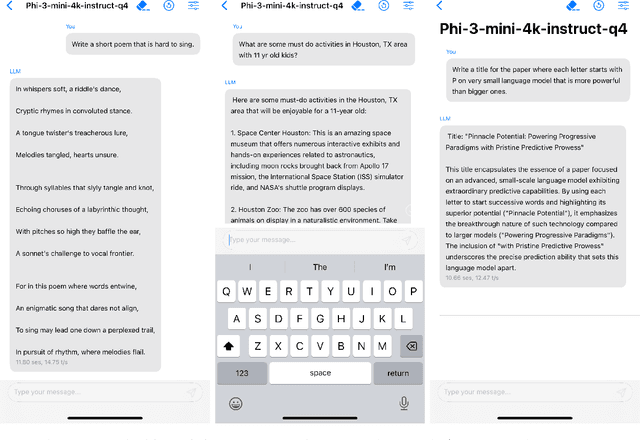

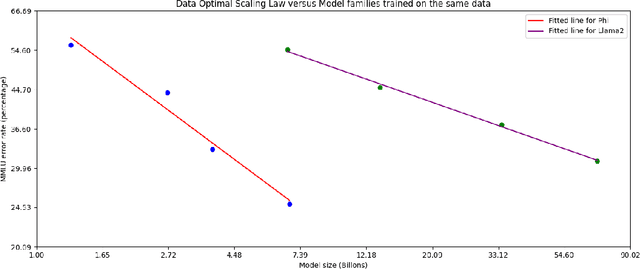
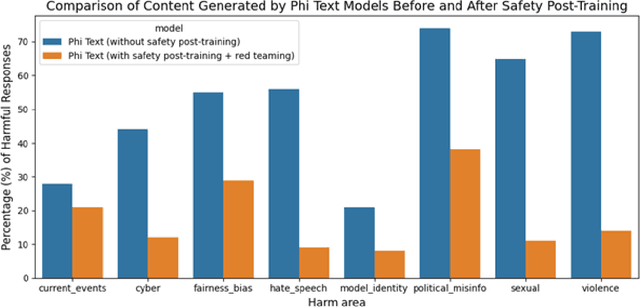
Abstract:We introduce phi-3-mini, a 3.8 billion parameter language model trained on 3.3 trillion tokens, whose overall performance, as measured by both academic benchmarks and internal testing, rivals that of models such as Mixtral 8x7B and GPT-3.5 (e.g., phi-3-mini achieves 69% on MMLU and 8.38 on MT-bench), despite being small enough to be deployed on a phone. The innovation lies entirely in our dataset for training, a scaled-up version of the one used for phi-2, composed of heavily filtered web data and synthetic data. The model is also further aligned for robustness, safety, and chat format. We also provide some initial parameter-scaling results with a 7B and 14B models trained for 4.8T tokens, called phi-3-small and phi-3-medium, both significantly more capable than phi-3-mini (e.g., respectively 75% and 78% on MMLU, and 8.7 and 8.9 on MT-bench).
A Length-Extrapolatable Transformer
Dec 20, 2022Abstract:Position modeling plays a critical role in Transformers. In this paper, we focus on length extrapolation, i.e., training on short texts while evaluating longer sequences. We define attention resolution as an indicator of extrapolation. Then we propose two designs to improve the above metric of Transformers. Specifically, we introduce a relative position embedding to explicitly maximize attention resolution. Moreover, we use blockwise causal attention during inference for better resolution. We evaluate different Transformer variants with language modeling. Experimental results show that our model achieves strong performance in both interpolation and extrapolation settings. The code will be available at https://aka.ms/LeX-Transformer.
TorchScale: Transformers at Scale
Nov 23, 2022Abstract:Large Transformers have achieved state-of-the-art performance across many tasks. Most open-source libraries on scaling Transformers focus on improving training or inference with better parallelization. In this work, we present TorchScale, an open-source toolkit that allows researchers and developers to scale up Transformers efficiently and effectively. TorchScale has the implementation of several modeling techniques, which can improve modeling generality and capability, as well as training stability and efficiency. Experimental results on language modeling and neural machine translation demonstrate that TorchScale can successfully scale Transformers to different sizes without tears. The library is available at https://aka.ms/torchscale.
Foundation Transformers
Oct 19, 2022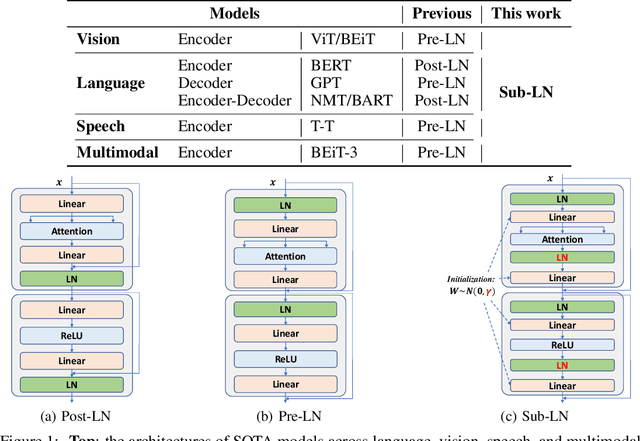
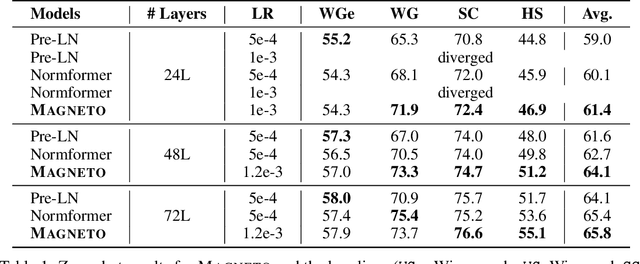
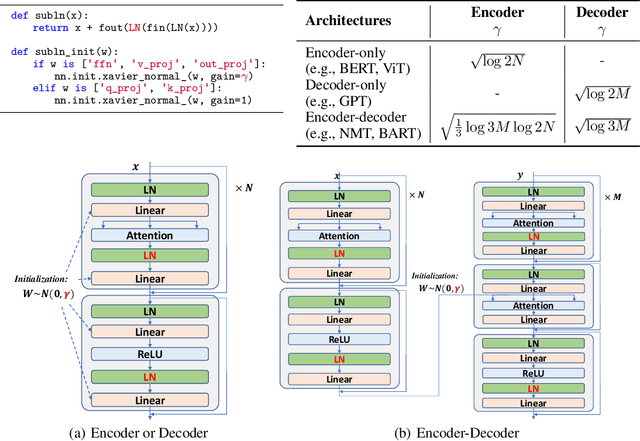
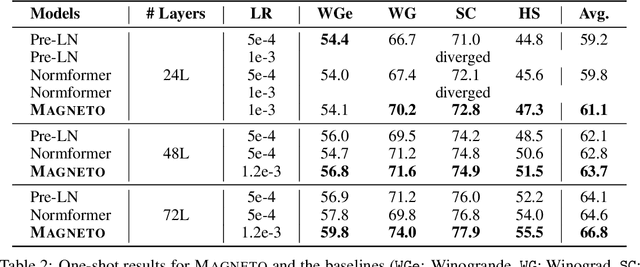
Abstract:A big convergence of model architectures across language, vision, speech, and multimodal is emerging. However, under the same name "Transformers", the above areas use different implementations for better performance, e.g., Post-LayerNorm for BERT, and Pre-LayerNorm for GPT and vision Transformers. We call for the development of Foundation Transformer for true general-purpose modeling, which serves as a go-to architecture for various tasks and modalities with guaranteed training stability. In this work, we introduce a Transformer variant, named Magneto, to fulfill the goal. Specifically, we propose Sub-LayerNorm for good expressivity, and the initialization strategy theoretically derived from DeepNet for stable scaling up. Extensive experiments demonstrate its superior performance and better stability than the de facto Transformer variants designed for various applications, including language modeling (i.e., BERT, and GPT), machine translation, vision pretraining (i.e., BEiT), speech recognition, and multimodal pretraining (i.e., BEiT-3).
 Add to Chrome
Add to Chrome Add to Firefox
Add to Firefox Add to Edge
Add to Edge